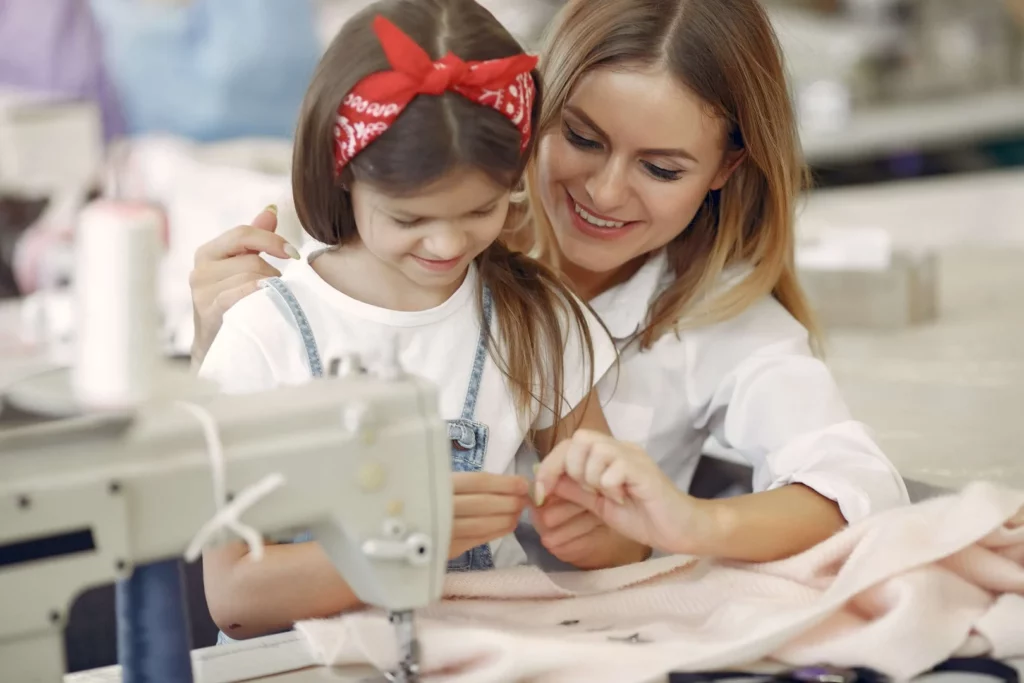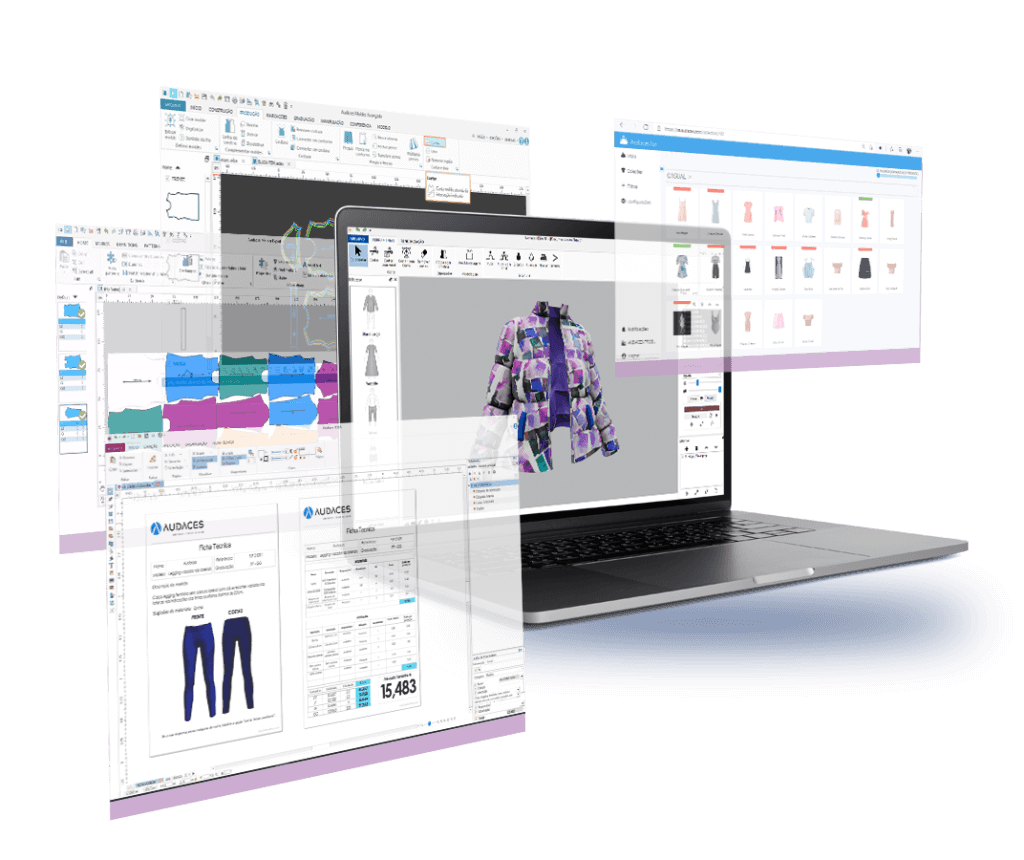Summary
- The kids’ clothing size chart is an important tool for enhancing the quality of your creations.
- For parents, designers, and anyone involved in clothing, the kids’ clothing size chart guides when purchasing or crafting garments.
- Experience complete collection management with the Audaces360 multi-solution! Start your free trial today.
Designing clothing for children requires a deep understanding of their ever-changing sizes. In this process, the utilization of a kids’ clothing size chart is crucial.
This chart not only illustrates how children grow at different ages but also accounts for their evolving body shapes.
It covers more than just lengths and girths; it ensures that the clothing allows children to play and move freely in their daily activities.
This resource is equally beneficial for designers, parents, and buyers.
Sumário
It facilitates the creation of well-fitting and comfortable clothes, enabling children to be delighted and stylish.
Enjoy your reading!
The importance of utilizing a kids’ clothing size chart in apparel stores
In apparel stores, a kids’ clothing size chart plays a pivotal role in enhancing the quality of offered garments, streamlining production processes, reducing costs, and, most importantly, meeting customer expectations.
Discover why incorporating a kids’ clothing size chart in apparel stores is indispensable:
Standardized sizing
Children have various sizes and shapes. A size chart allows clothing companies to standardize the sizes of their garments, ensuring a proper fit for a wide range of children.
This, in turn, minimizes the likelihood of customer complaints regarding ill-fitting clothing.
Learn more: Explore clothing pattern-making techniques for your production
Enhanced customer experience
By offering consistent and accurate sizes, apparel manufacturers can improve the overall customer experience.
Parents and guardians will be delighted to find clothing that fits their children well, eliminating the need for frequent returns or exchanges.
Production efficiency
A well-defined measurement table empowers manufacturers to plan the production of children’s clothing with greater efficiency.
This not only reduces material and resource wastage but also optimizes the cutting and sewing processes.
Learn more: Enhance productivity in sectors of the textile industry with technology
Cost reduction
Returns stemming from sizing issues can be a significant expense for clothing manufacturers, encompassing return shipping costs, refunds, and the need to handle returned items.
An accurate measurement table is instrumental in minimizing these expenditures.
Learn more: Discover how to reduce costs in wholesale clothing production
Building trust in your brand
Clothing companies that consistently provide well-fitting garments that meet customer expectations can establish a reputation of trustworthiness.
This reputation can foster greater customer loyalty and drive repeat sales.
Inventory management
By leveraging common measurements and assessing the demand for various sizes, clothing manufacturers can enhance their inventory planning.
This approach allows them to steer clear of overstocking or falling short of popular sizes, optimizing both production and stock levels.
What to consider when creating your own kids’ clothing size chart?
When creating your very own kids’ clothing size chart, it’s crucial to invest time and effort into crafting a meticulous and purposeful table.
Crafting an accurate, comprehensive, and customer-centric sizing chart is essential. Here’s a guide on what factors to keep in mind:
Age group and gender
Define the specific age groups and genders for which you’re designing clothing. Measurements can vary significantly between infants, preschoolers, and older children.
Also, create separate charts for boys and girls, recognizing the potential differences in body proportions.
Key measurements
Identify the critical measurements you intend to include in your size chart. This may encompass height, weight, chest circumference, waist, hips, arm length, and more.
Consider which body parts are most relevant to the fit of the clothing you’re producing.
Current size standards
Research existing size standards for children’s clothing. Many countries have established sizing guidelines, such as ISO standards or industry charts.
These standards can serve as a foundation for your measurements.
Representative sampling
When collecting data for your size chart, ensure it encompasses a representative sample of children from various age groups, sizes, and proportions.
This diverse data collection will help ensure that your measurements cater to a broad spectrum of children.
Room for growth
Always bear in mind that children experience continuous growth.
When devising your measurements, incorporate some allowance for growth, ensuring the clothing accommodates their development over an extended period of wear.
Simplicity and clarity
Maintain simplicity and clarity in your size chart. Employ standardized units of measurement, such as centimeters, and arrange the measurements in a clear, organized fashion.
This enables customers to effortlessly identify their corresponding sizes.
Testing and adjustments
Following the creation of your chart, conduct rigorous testing with a sample group of children to verify proper fit and measurement accuracy.
Be prepared to make necessary adjustments based on the test results, fine-tuning the chart for precision.
Periodic update
Children’s body proportions can evolve over time due to factors like dietary changes, physical activity, and growth spurts.
As a result, it’s advisable to schedule periodic updates for your measurement chart, ensuring that it remains consistently accurate and aligned with changing child development.
How to craft a comprehensive kids’ clothing size chart?

To create a precise and effective kids’ clothing size chart, a continual process of research, testing, and refinement is essential.
Attention to detail and an unwavering commitment to meeting the unique needs of children are vital for the success of your children’s clothing in the market.
This endeavor involves several critical steps to ensure accuracy and appropriateness. Here’s what they entail:
Investigate competitor measurement tables
Begin your journey by examining the children’s clothing size chart used by competitors or well-established brands in the children’s clothing industry.
This research will provide valuable insights into common practices and typical measurements utilized in the field.
Define size grids and age ranges
Establish the specific age groups you intend to cater to, such as infants, preschoolers, and older children.
Develop a size grid that encompasses these age ranges, spanning from newborn to teen sizes.
Subdivide each age range into distinct size categories, for instance, 0-3 months, 3-6 months, 6-9 months, and so on.
Identify key measurement points
Begin by determining the primary measurement points that are critical for achieving the proper fit of clothing.
These may encompass factors such as height, weight, chest circumference, waist, hips, arm length, and leg length, among others.
Use official measurement tables as a reference
Seek guidance from official technical standards that outline body measurement guidelines for children. Examples of these standards include the ASTM International standards, ISO standards, or country-specific guidelines, such as the ones from The Brazilian Association of Technical Standards (ABNT).
These established standards serve as dependable references for developing your own measurements in each respective country.
Learn more: Check out 8 advantages of the clothing measurements chart for the fashion business
Consider child growth
Always keep in mind the rapid growth experienced by children.
When formulating your measurements, incorporate an allowance for growth to accommodate their evolving physical development over time.
Craft the most precise kids’ clothing size chart with Audaces solutions
In the realm of clothing manufacturing, technology plays a pivotal role in streamlining processes, especially for children’s apparel.
Explore the innovative world of Audaces and its software solutions designed to revolutionize the speed, quality, and efficiency of clothing production.
Audaces360

Audaces360 stands as a versatile platform that seamlessly connects all creative and production stages, enhancing the precision and profitability of your clothing manufacturing endeavors.
It offers a comprehensive view of the entire production process, working in harmony with other tools to ensure each phase contributes synergistically to the next.
Fueled by accurate and real-time information, Audaces360 empowers quick and effective decision-making. Its myriad features expedite garment production and facilitate order customization, ultimately enhancing overall operational efficiency.
Discover two essential software components of Audaces360:
Audaces Idea
Audaces Idea software is an asset for fostering agility and communication throughout the creation process within your manufacturing business. It standardizes procedures and augments precision at every stage.
Audaces Idea aids in cost estimation and seamlessly integrates technical drawings with technical sheets. It empowers you to define control points, craft volumes and curves in your designs, and seamlessly incorporate print images while adjusting their dimensions as needed on the fabric.
These technical details enable you to anticipate the costs associated with the entire fashion creation process, including required materials and production timelines.
This is particularly beneficial for designers, offering the opportunity to evaluate pieces commercially before commencing production.
Audaces Pattern
Audaces Pattern is an invaluable tool for those seeking to elevate the efficiency of their collection production. Featuring an intuitive interface, it’s renowned for its remarkable speed in crafting digital patterns, outpacing traditional manual methods.
Moreover, Audaces Pattern offers an automatic measurement table, simplifying the pattern creation process, even for intricate designs, while expediting size adjustments. This also contributes to a reduction in paper usage during pattern creation.
Explore the guide we’ve prepared for you to effortlessly create your fashion technical sheets and secure two exclusive worksheets.
Download our infographic to gain insight into the comprehensive requirements for a practical and agile manufacturing process.
Grab yours now – it’s swift and free:
FAQ
A kids’ clothing size chart in stores is essential for quality improvement, production optimization, cost reduction, and exceeding customer expectations.
When crafting your kids’ clothing size chart, ensure accuracy and suitability by considering various factors aligned with your customers’ needs.
Developing a precise chart demands continuous research, testing, and refinement. Detail-oriented approaches that cater to children’s requirements are key to success in the market.










